Foot Afflictions Confused With Plantar Fasciitis

Plantar fasciitis is a very common foot condition that affects a wide variety of individuals across the country. This condition occurs when the plantar fascia, which is the band of tissue that runs along the arch of the foot, becomes aggravated and inflamed due to repeated pressure and strain. Although plantar fasciitis causes pain that is primarily in the arch and heel of the foot, pain can sometimes feel like it is emanating to other areas such as the ankle. Plantar fasciitis can be confused with a ruptured plantar fascia. Although both conditions involve the plantar fascia, plantar fasciitis is defined by micro-tears to this band of tissue, as opposed to the more significant tears involved in a ruptured plantar fascia. Additionally, plantar fasciitis is often confused with the entrapment of the nerves. For example, when the tibial nerve becomes pinched, sensations of pain can be felt in the soles of the feet in a way that is similar to plantar fasciitis. One of the distinguishing factors, however, is that tingling and numbness can be felt in the soles of the feet with a pinched tibial nerve. If you are having difficulty determining whether or not your pain is due to plantar fasciitis or another condition, contact a podiatrist who can perform a proper diagnosis.
Plantar fasciitis can be very painful and inconvenient. If you are experiencing heel pain or symptoms of plantar fasciitis, contact Harvey Jacobs, DPM from Quality Foot Care Center. Our doctor can provide the care you need to keep you pain-free and on your feet.
What Is Plantar Fasciitis?
Plantar fasciitis is the inflammation of the thick band of tissue that runs along the bottom of your foot, known as the plantar fascia, and causes mild to severe heel pain.
What Causes Plantar Fasciitis?
- Excessive running
- Non-supportive shoes
- Overpronation
- Repeated stretching and tearing of the plantar fascia
How Can It Be Treated?
- Conservative measures – anti-inflammatories, ice packs, stretching exercises, physical therapy, orthotic devices
- Shockwave therapy – sound waves are sent to the affected area to facilitate healing and are usually used for chronic cases of plantar fasciitis
- Surgery – usually only used as a last resort when all else fails. The plantar fascia can be surgically detached from the heel
While very treatable, plantar fasciitis is definitely not something that should be ignored. Especially in severe cases, speaking to your doctor right away is highly recommended to avoid complications and severe heel pain. Your podiatrist can work with you to provide the appropriate treatment options tailored to your condition.
If you have any questions please feel free to contact our office located in Somerset, NJ . We offer the newest diagnostic and treatment technologies for all your foot and ankle needs.
How Body Weight Can Affect the Feet

Many parts of the body become smaller when excess weight is lost, and this is also true of the feet. It is beneficial to have the feet properly measured when purchasing new shoes, and this will help to ensure a good fit. Research has indicated the feet absorb approximately 120 percent of the body’s weight, and this may explain why foot pain may occur. The excess weight may stretch tissues and muscles, in addition to natural fad pads wearing down. Additionally, the feet and ankles may swell from the added weight, and may generally feel uncomfortable. Many patients have noticed that by losing weight, their feet will feel better, and existing foot conditions may be alleviated. The bone structure of the foot may not change, but the width may be affected, and become smaller. It is beneficial to exercise as often as possible, and this can help the health of the feet. Eating foods that are low in sodium can help to diminish existing swelling, and wearing shoes may become easier. If you have questions about foot health before or after weight is lost, please consult with a podiatrist who can address any concerns you may have.
The more you weigh, the harder your feet must work to support your body. If you’re an obese individual and are concerned about your feet, contact Harvey Jacobs, DPM from Quality Foot Care Center. Our doctor can provide the care you need to keep you pain-free and on your feet.
Obesity and Your Feet
People who are overweight are putting more pressure on their ankles, knees, and hips as well as their feet. This unfortunately can lead to variety of different issues.
Problems & Complications Stemming from Obesity
- When the body is overweight, it tries to compensate by changing the way that it moves. An obese person may lean forward and put extra weight on the wrong part of the foot. This puts unnecessary stress on the feet.
- Obese people are also more likely to develop type II diabetes which is a condition that causes a lot of foot problems. People with diabetes often don’t feel the cuts and sores that they may have on their feet, which can lead to more complicated and severe issues.
- Plantar fasciitis is another foot condition that can be caused by obesity. Plantar fasciitis is an inflammation of the tissue along the bottom of the foot, which causes pain and stiffness while walking and climbing stairs.
If you have any questions, please feel free to contact our office located in Somerset, NJ . We offer the newest diagnostic and treatment technologies for all your foot care needs.
Several Reasons for Poor Circulation in the Feet

Poor circulation in the feet is common among diabetic patients. Acrocyanosis, which is a condition that can affect the extremities, and arteriosclerosis which can be triggered by high blood pressure are other reasons why this condition can develop. Poor circulation in the feet is the result of closed or narrow blood vessels, and patients who have this may be at risk for other health issues. Some of the symptoms that are associated with this condition include hair loss on the feet and legs, and dry or cracked skin. Additionally, people who have poor circulation may have weak toenails, and their feet may feel cold and have a bluish tint. The medical condition known as Raynaud’s disease syndrome may cause the blood vessels in the feet to become narrow, and this can limit the amount of blood that circulates. Additionally, peripheral artery disease (PAD) may contribute to poor circulation. This can cause the inability to feel existing cuts and scrapes that may have developed on the feet as a result of excessive plaque build up in the arteries. If you have poor circulation in your feet for any reason, please contact a podiatrist who can properly diagnose and treat this ailment.
Poor circulation is a serious condition and needs immediate medical attention. If you have any concerns with poor circulation in your feet contact Harvey Jacobs, DPM of Quality Foot Care Center. Our doctor will treat your foot and ankle needs.
Poor Circulation in the Feet
Poor blood circulation in the feet and legs is can be caused by peripheral artery disease (PAD), which is the result of a buildup of plaque in the arteries.
Plaque buildup or atherosclerosis results from excess calcium and cholesterol in the bloodstream. This can restrict the amount of blood which can flow through the arteries. Poor blood circulation in the feet and legs are sometimes caused by inflammation in the blood vessels, known as vasculitis.
Causes
Lack of oxygen and oxygen from poor blood circulation restricts muscle growth and development. It can also cause:
- Muscle pain, stiffness, or weakness
- Numbness or cramping in the legs
- Skin discoloration
- Slower nail & hair growth
- Erectile dysfunction
Those who have diabetes or smoke are at greatest risk for poor circulation, as are those who are over 50. If you have poor circulation in the feet and legs it may be caused by PAD and is important to make changes to your lifestyle in order to reduce risk of getting a heart attack or stroke. Exercise and maintaining a healthy lifestyle will dramatically improve conditions.
As always, see a podiatrist as he or she will assist in finding a regimen that suits you. A podiatrist can also prescribe you any needed medication.
If you have any questions please feel free to contact our office located in Somerset, NJ . We offer the newest diagnostic and treatment technologies for all your foot and ankle needs.
Typical Pregnancy Foot Problems

Although it might not seem immediately intuitive to some pregnant women, pregnancy can seriously impact and affect the feet. While a baby grows inside a pregnant woman, the woman’s center of gravity changes, forcing the feet to adapt. Additionally, during pregnancy, the woman produces a variety of pregnancy hormones that can have significant effects on the feet. One typical problem that you might encounter during your pregnancy is flat feet. Flat feet occur when the feet lose their natural arch and the entire foot presses directly against the ground when standing. Pregnant women can sometimes develop flat feet because as they gain a notable amount of weight, they exert more and more pressure on the feet, which can reduce the arch in the feet. Secondly, another common pregnancy foot problem is swelling in the feet. Swollen feet can frequently occur in pregnant women because, throughout the pregnancy, the pregnant woman’s body must produce a significantly larger amount of blood to support the growing baby. This excess of blood and fluids might sometimes lead to swelling in the feet. As a result, you might notice your foot size increasing, causing your feet to temporarily require larger shoes. If you are pregnant, it might be a good idea to reach out to your podiatrist who can help you manage symptoms on your feet.
Pregnant women with swollen feet can be treated with a variety of different methods that are readily available. For more information about other cures for swollen feet during pregnancy, consult with Harvey Jacobs, DPM from Quality Foot Care Center. Our doctor will attend to all of your foot and ankle needs.
What Foot Problems Can Arise During Pregnancy?
One problem that can occur is overpronation, which occurs when the arch of the foot flattens and tends to roll inward. This can cause pain and discomfort in your heels while you’re walking or even just standing up, trying to support your baby.
Another problem is edema, or swelling in the extremities. This often affects the feet during pregnancy but tends to occur in the later stages.
How Can I Keep My Feet Healthy During Pregnancy?
- Wearing orthotics can provide extra support for the feet and help distribute weight evenly
- Minimize the amount of time spent walking barefoot
- Wear shoes with good arch support
- Wear shoes that allow for good circulation to the feet
- Elevate feet if you experience swelling
- Massage your feet
- Get regular, light exercise, such as walking, to promote blood circulation to the feet
If you have any questions please feel free to contact our office located in Somerset, NJ . We offer the newest diagnostic and treatment technologies for all your foot and ankle needs.
Are You Suffering From Ingrown Toenails?
How Flat Feet Affects Runners
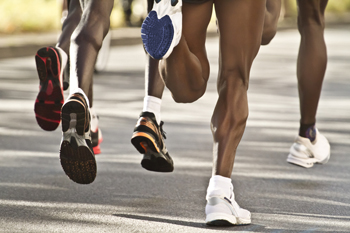 Flat feet are a condition where the patient exhibits little or no arch in their feet. In other words, every part of the bottom of the foot, also known as the sole, rests entirely against the floor when standing on both feet. An individual can develop flat feet naturally as a matter of genetics, or in response to injury, aging, or pregnancy. Whatever the cause, flat feet can be a headache for runners. If you are running with flat feet, you might experience pain in the feet or knees. This may be caused by overpronation whereby some patients with flat feet excessively roll their feet inward to absorb shocks when walking or running. This possible overpronation can cause muscles in the feet to tighten. Also, flat feet might cause problems when running because the condition increases a runner’s susceptibility to suffering an injury or developing tendinitis. Tendinitis can affect the tendons around the heels and knees, essentially inflaming the tendon, which can lead to pain and tenderness. If you are a runner with flat feet, consider reaching out to a podiatrist who can help you address the problem. A podiatrist may recommend running with orthotics or shoe inserts to correct any possible overpronation.
Flat feet are a condition where the patient exhibits little or no arch in their feet. In other words, every part of the bottom of the foot, also known as the sole, rests entirely against the floor when standing on both feet. An individual can develop flat feet naturally as a matter of genetics, or in response to injury, aging, or pregnancy. Whatever the cause, flat feet can be a headache for runners. If you are running with flat feet, you might experience pain in the feet or knees. This may be caused by overpronation whereby some patients with flat feet excessively roll their feet inward to absorb shocks when walking or running. This possible overpronation can cause muscles in the feet to tighten. Also, flat feet might cause problems when running because the condition increases a runner’s susceptibility to suffering an injury or developing tendinitis. Tendinitis can affect the tendons around the heels and knees, essentially inflaming the tendon, which can lead to pain and tenderness. If you are a runner with flat feet, consider reaching out to a podiatrist who can help you address the problem. A podiatrist may recommend running with orthotics or shoe inserts to correct any possible overpronation.
Flatfoot is a condition many people suffer from. If you have flat feet, contact Harvey Jacobs, DPM from Quality Foot Care Center. Our doctor will treat your foot and ankle needs.
What Are Flat Feet?
Flatfoot is a condition in which the arch of the foot is depressed and the sole of the foot is almost completely in contact with the ground. About 20-30% of the population generally has flat feet because their arches never formed during growth.
Conditions & Problems:
Having flat feet makes it difficult to run or walk because of the stress placed on the ankles.
Alignment – The general alignment of your legs can be disrupted, because the ankles move inward which can cause major discomfort.
Knees – If you have complications with your knees, flat feet can be a contributor to arthritis in that area.
Symptoms
- Pain around the heel or arch area
- Trouble standing on the tip toe
- Swelling around the inside of the ankle
- Flat look to one or both feet
- Having your shoes feel uneven when worn
Treatment
If you are experiencing pain and stress on the foot you may weaken the posterior tibial tendon, which runs around the inside of the ankle.
If you have any questions please feel free to contact our office located in Somerset, NJ . We offer the newest diagnostic and treatment technologies for all your foot and ankle needs.
Are Orthotics Right for Me?
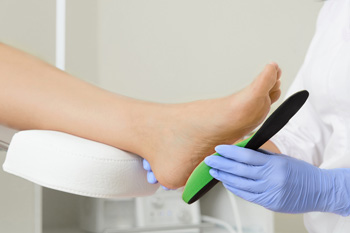
Many people need to wear orthotics in their shoes. They are defined as custom-made insoles that can help a variety of foot conditions and may also be used to improve ankle support. A proper diagnosis can determine if orthotics are right for you. This can consist of having a physical examination performed on the feet, discussing existing symptoms, and checking for painful deformities. Additionally, an X-ray or MRI may be ordered that can show any signs of arthritis or damage to the foot. There are some foot conditions that can alter the foot structure including bunions, hammertoes, heel spurs, or flat feet. There are two categories of orthotics consisting of rigid and flexible and may be available in two sizes, full-shoe inserts or smaller inserts that the heels can fit in. If you have a foot ailment and would like more information about the benefits of wearing custom-made orthotics, it is strongly advised that you seek the counsel of a podiatrist.
If you are having discomfort in your feet and would like to try orthotics, contact Harvey Jacobs, DPM from Quality Foot Care Center. Our doctor can provide the care you need to keep you pain-free and on your feet.
What Are Orthotics?
Orthotics are inserts you can place into your shoes to help with a variety of foot problems such as flat feet or foot pain. Orthotics provide relief and comfort for minor foot and heel pain but can’t correct serious biomechanical problems in your feet.
Over-the-Counter Inserts
Orthotics come in a wide variety of over-the-counter inserts that are used to treat foot pain, heel pain, and minor problems. For example, arch supports can be inserted into your shoes to help correct overarched or flat feet, while gel insoles are often used because they provide comfort and relief from foot and heel pain by alleviating pressure.
Prescription Orthotics
If over-the-counter inserts don’t work for you or if you have a more severe foot concern, it is possible to have your podiatrist prescribe custom orthotics. These high-quality inserts are designed to treat problems such as abnormal motion, plantar fasciitis, and severe forms of heel pain. They can even be used to help patients suffering from diabetes by treating foot ulcers and painful calluses and are usually molded to your feet individually, which allows them to provide full support and comfort.
If you are experiencing minor to severe foot or heel pain, it’s recommended to speak with your podiatrist about the possibilities of using orthotics. A podiatrist can determine which type of orthotic is right for you and allow you to take the first steps towards being pain-free.
If you have any questions please contact our office located in Somerset, NJ . We offer the newest diagnostic and treatment technologies for all your foot and ankle needs.
When Do Feet Stop Growing?
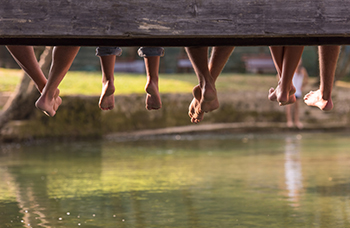
The feet are considered to be the foundation of the body. Their function is to provide stability and balance to the body, in addition to making it possible to stand, walk and run. Children’s feet grow rapidly to keep up with the rest of their bodies, and will grow faster during puberty. As the child approaches adulthood, the bones in the feet become larger, and will continue to grow until the age of approximately twenty. There are 26 bones in each foot, and the bones in both feet add up to one quarter of the bones in the body. An interesting fact is the feet have the most sweat glands per square centimeter, and 125,000 of them are located on each sole. Additionally, the feet have 8000 nerve endings, and this can contribute to the feet being one of the most ticklish areas of the body. Research has indicated that toenails grow slower than fingernails, and a toenail can take 12 to 18 months to fully grow. If you would like to know more about foot structure, and interesting information about the feet, please consult with a podiatrist.
If you have any concerns about your feet, contact Harvey Jacobs, DPM from Quality Foot Care Center. Our doctor can provide the care you need to keep you pain-free and on your feet.
Biomechanics in Podiatry
Podiatric biomechanics is a particular sector of specialty podiatry with licensed practitioners who are trained to diagnose and treat conditions affecting the foot, ankle and lower leg. Biomechanics deals with the forces that act against the body, causing an interference with the biological structures. It focuses on the movement of the ankle, the foot and the forces that interact with them.
A History of Biomechanics
- Biomechanics dates back to the BC era in Egypt where evidence of professional foot care has been recorded.
- In 1974, biomechanics gained a higher profile from the studies of Merton Root, who claimed that by changing or controlling the forces between the ankle and the foot, corrections or conditions could be implemented to gain strength and coordination in the area.
Modern technological improvements are based on past theories and therapeutic processes that provide a better understanding of podiatric concepts for biomechanics. Computers can provide accurate information about the forces and patterns of the feet and lower legs.
Understanding biomechanics of the feet can help improve and eliminate pain, stopping further stress to the foot.
If you have any questions please feel free to contact our office located in Somerset, NJ . We offer the newest diagnostic and treatment technologies for all your foot and ankle needs.
Hammertoe, Mallet Toe and Claw Toe
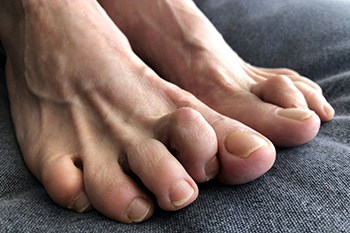
For most people, toe deformities show up later in life, often as the result of wearing improper or ill-fitting footwear for many years. These deformities also can be caused by nerve or muscle damage, as well as a number of other conditions. The three most common deformities of the toe joints are similar but not the same: hammertoe, mallet toe, and claw toe. The toes have a number of joints, two in the big toe and three in the other toes. Hammertoe and mallet toe affect one joint. Claw toe affects all three joints. Hammertoe occurs when the middle joint bends down to the floor, causing the other joints to bend up. This results in a bump on the top of the toe. With a mallet toe, most common to the 2nd toe, the end joint flexes permanently, preventing the toe from straightening. Claw toe occurs when the two end joints flex and curl the toe downward. As a result the first joint compensates by hyperextending, resulting in a curled toe that looks like a claw. It often affects the four smaller toes. If you have developed any of these deformities, please consult a podiatrist for an exam and possible treatment options.
Hammertoe
Hammertoes can be a painful condition to live with. For more information, contact Harvey Jacobs, DPM from Quality Foot Care Center. Our doctor will answer any of your foot- and ankle-related questions.
Hammertoe is a foot deformity that affects the joints of the second, third, fourth, or fifth toes of your feet. It is a painful foot condition in which these toes curl and arch up, which can often lead to pain when wearing footwear.
Symptoms
- Pain in the affected toes
- Development of corns or calluses due to friction
- Inflammation
- Redness
- Contracture of the toes
Causes
Genetics – People who are genetically predisposed to hammertoe are often more susceptible
Arthritis – Because arthritis affects the joints in your toes, further deformities stemming from arthritis can occur
Trauma – Direct trauma to the toes could potentially lead to hammertoe
Ill-fitting shoes – Undue pressure on the front of the toes from ill-fitting shoes can potentially lead to the development of hammertoe
Treatment
Orthotics – Custom made inserts can be used to help relieve pressure placed on the toes and therefore relieve some of the pain associated with it
Medications – Oral medications such as anti-inflammatories or NSAIDs could be used to treat the pain and inflammation hammertoes causes. Injections of corticosteroids are also sometimes used
Surgery – In more severe cases where the hammertoes have become more rigid, foot surgery is a potential option
If you have any questions please contact our office located in Somerset, NJ . We offer the newest diagnostic and treatment technologies for all your foot and ankle needs.
Why Live with Pain and Numbness in Your Feet?
More...
Is My Toe Broken or Bruised?
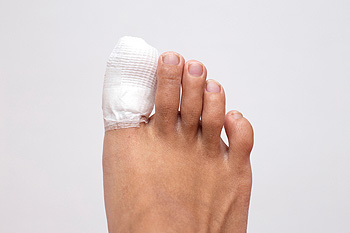
The most common method of differentiating between a broken toe and a bruised toe is to have an X-ray taken. They both can cause severe pain and discomfort. A severely broken toe can look deformed, and the bone can protrude from the toe at an abnormal angle. The symptoms that are associated with both of these types of injuries can include swelling, bruising, and difficulty walking. The buddy taping system for a bruised toe can cause the affected toe to feel better, as a result of the stability it provides. This is done by taping the toe to the toe next to it, and having it remain that way for several days. The buddy taping method works well for broken toes, as it causes the injured toe to remain still as the healing process occurs. In both scenarios, it is suggested to refrain from putting weight on the foot, which gives the broken or bruised toe ample time to heal. If you think you have broken or bruised your toe, it is advised to have it checked by a podiatrist who can guide you toward the proper treatment.
Broken toes may cause a lot of pain and should be treated as soon as possible. If you have any concerns about your feet, contact Harvey Jacobs, DPM from Quality Foot Care Center. Our doctor will treat your foot and ankle needs.
What Is a Broken Toe?
A broken toe occurs when one or more of the toe bones of the foot are broken after an injury. Injuries such as stubbing your toe or dropping a heavy object on it may cause a toe fracture.
Symptoms of a Broken Toe
- Swelling
- Pain (with/without wearing shoes)
- Stiffness
- Nail Injury
Although the injured toe should be monitored daily, it is especially important to have a podiatrist look at your toe if you have severe symptoms. Some of these symptoms include worsening or new pain that is not relieved with medication, sores, redness, or open wounds near the toe.
If you have any questions, please feel free to contact our office located in Somerset, NJ . We offer the newest diagnostic and treatment technologies for all your foot care needs.
Treating Poor Circulation in the Feet
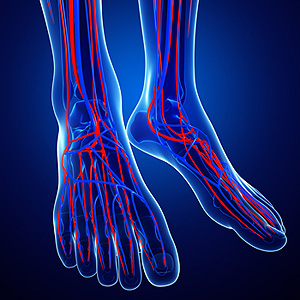
When blood circulation to the feet becomes impaired, an individual may suffer a variety of negative consequences. For example, when circulation slows, the feet can become numb, discolored, and cold. In some cases, poor circulation might even cause hair loss below the knees and cracked skin on the feet. Pregnant women and individuals suffering from diabetes are at a particular risk of suffering from poor circulation. However, there are several steps that you can take to improve and promote blood circulation to your feet. First, you might consider purchasing a pair of compression socks, which exert pressure on your feet, effectively encouraging circulation by forcing blood vessels to travel up to the heart. To promote better circulation, you might also try simply adding more physical activity to your daily routine if you are someone who spends a significant part of your day at rest. By increasing movement, you can effectively loosen arteries and facilitate blood circulation. Lastly, you might try massaging your feet to jump start blood circulation throughout the feet. Contacting a podiatrist may help you better understand ways that you can increase blood circulation in your feet.
While poor circulation itself isn’t a condition; it is a symptom of another underlying health condition you may have. If you have any concerns with poor circulation in your feet contact Harvey Jacobs, DPM of Quality Foot Care Center. Our doctor will treat your foot and ankle needs.
Poor Circulation in the Feet
Peripheral artery disease (PAD) can potentially lead to poor circulation in the lower extremities. PAD is a condition that causes the blood vessels and arteries to narrow. In a linked condition called atherosclerosis, the arteries stiffen up due to a buildup of plaque in the arteries and blood vessels. These two conditions can cause a decrease in the amount of blood that flows to your extremities, therefore resulting in pain.
Symptoms
Some of the most common symptoms of poor circulation are:
- Numbness
- Tingling
- Throbbing or stinging pain in limbs
- Pain
- Muscle Cramps
Treatment for poor circulation often depends on the underlying condition that causes it. Methods for treatment may include insulin for diabetes, special exercise programs, surgery for varicose veins, or compression socks for swollen legs.
As always, see a podiatrist as he or she will assist in finding a regimen that suits you. A podiatrist can also prescribe you any needed medication.
If you have any questions, please feel free to contact our office located in Somerset, NJ . We offer the newest diagnostic and treatment technologies for all your foot care needs.
Dealing With Running Injuries
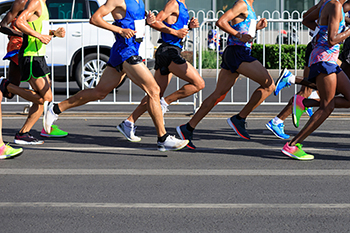
Running is generally thought to be good for overall physical fitness, especially as it applies to cardiovascular health. It also leaves the runner open to several injuries, including plantar fasciitis, bruised heel, and a stress fracture of the heel bone. Other common foot problems associated with running are bunions, ingrown toenails, blisters, and metatarsal stress fractures. These foot conditions can further contribute to pain and discomfort in other body parts like the ankles, legs, knees, and back. Dealing with injuries from running becomes part of a runner’s life and paying attention to your feet is paramount in maintaining a healthy body. Establishing an ongoing relationship with a podiatrist is a wise choice for anyone who intends to make running a part of their life. Signs that it may be time to make an appointment include severe pain when walking, apparent swelling or bruising, and a feeling of numbness or tingling. A podiatrist can examine your feet to determine the cause of your symptoms and offer appropriate treatment plans.
Sports related foot and ankle injuries require proper treatment before players can go back to their regular routines. For more information, contact Harvey Jacobs, DPM of Quality Foot Care Center. Our doctor can provide the care you need to keep you pain-free and on your feet.
Sports Related Foot and Ankle Injuries
Foot and ankle injuries are a common occurrence when it comes to athletes of any sport. While many athletes dismiss the initial aches and pains, the truth is that ignoring potential foot and ankle injuries can lead to serious problems. As athletes continue to place pressure and strain the area further, a mild injury can turn into something as serious as a rupture and may lead to a permanent disability. There are many factors that contribute to sports related foot and ankle injuries, which include failure to warm up properly, not providing support or wearing bad footwear. Common injuries and conditions athletes face, including:
- Plantar Fasciitis
- Plantar Fasciosis
- Achilles Tendinitis
- Achilles Tendon Rupture
- Ankle Sprains
Sports related injuries are commonly treated using the RICE method. This includes rest, applying ice to the injured area, compression and elevating the ankle. More serious sprains and injuries may require surgery, which could include arthroscopic and reconstructive surgery. Rehabilitation and therapy may also be required in order to get any recovering athlete to become fully functional again. Any unusual aches and pains an athlete sustains must be evaluated by a licensed, reputable medical professional.
If you have any questions please feel free to contact our office located in Somerset, NJ . We offer the newest diagnostic and treatment technologies for all your foot and ankle needs.
Say Goodnight to Nocturnal Muscle Cramps in Your Feet
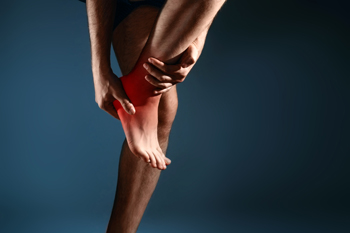
It’s hard enough getting a good night’s sleep without muscle cramps in your feet keeping you awake. The nocturnal foot cramps you may be experiencing are actually contractions in the muscles or muscle fibers in your feet. Foot cramps occurring at night may be caused by muscle fatigue due to overtaxing the feet muscles, low levels of potassium (hypokalemia) or magnesium, medication side effects, pregnancy, or shoes that are too tight or that fail to provide adequate arch support. There are certain medical issues that may lead to nocturnal foot cramps, including arthritis, high blood pressure, diabetes, depression, thyroid disease, asthma, and heart attacks. Other contributing factors to developing these troublesome cramps are pregnancy, smoking, obesity, old age, and poor health. Consult with a podiatrist if your nocturnal muscle cramps do not improve within a couple of weeks to receive an accurate diagnosis and to discuss your treatment options.
Foot Pain
Foot pain can be extremely painful and debilitating. If you have a foot pain, consult with Harvey Jacobs, DPM from Quality Foot Care Center. Our doctor will assess your condition and provide you with quality foot and ankle treatment.
Causes
Foot pain is a very broad condition that could be caused by one or more ailments. The most common include:
- Bunions
- Hammertoes
- Plantar Fasciitis
- Bone Spurs
- Corns
- Tarsal Tunnel Syndrome
- Ingrown Toenails
- Arthritis (such as Gout, Rheumatoid, and Osteoarthritis)
- Flat Feet
- Injury (from stress fractures, broken toe, foot, ankle, Achilles tendon ruptures, and sprains)
- And more
Diagnosis
To figure out the cause of foot pain, podiatrists utilize several different methods. This can range from simple visual inspections and sensation tests to X-rays and MRI scans. Prior medical history, family medical history, and any recent physical traumatic events will all be taken into consideration for a proper diagnosis.
Treatment
Treatment depends upon the cause of the foot pain. Whether it is resting, staying off the foot, or having surgery; podiatrists have a number of treatment options available for foot pain.
If you have any questions, please feel free to contact our office located in Somerset, NJ . We offer the newest diagnostic and treatment technologies for all your foot care needs.


